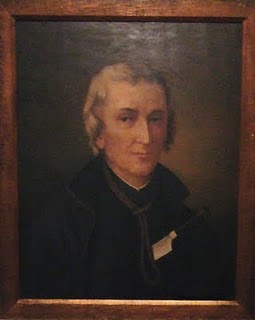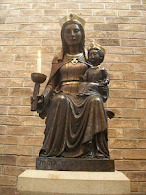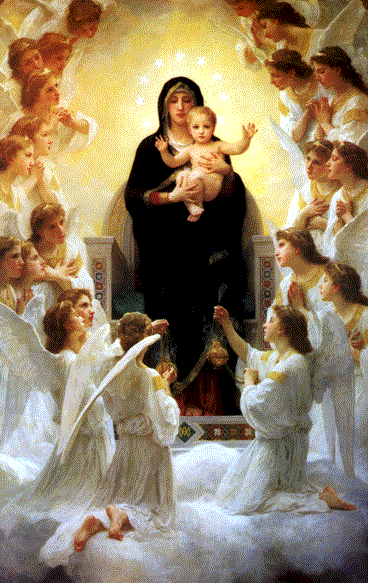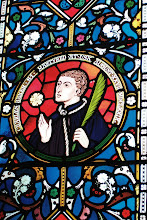On 25th October 1970, Pope Paul VI canonised forty martyrs from England and Wales. The Forty Martyrs of England and Wales were a diverse group - men and women, priests and lay people – but, between the years of 1535 and 1679, they all shed their blood for their Catholic faith. Saint David Lewis was the last of the forty to die. Ten of the Forty Martyrs of England and Wales, including Saint David Lewis, were Jesuits. Our intention is to tell, briefly, the story of each of the Jesuits. (SEE PREVIOUS POSTS FOR PARTS 1, 2 & 3)
7) ST EDMUND ARROWSMITH was born in Lancashire in 1585. His parents were devout Catholics who had been fined and even imprisoned for recusancy. In December 1605, Edmund travelled to Flanders and entered the English College at Douai. Having survived several bouts of ill health, Edmund was finally ordained in Arras on 9th December 1612 and sent upon the English Mission on 17th June 1613. In 1622, he was arrested and imprisoned but he was pardoned and released. In 1624, Fr Arrowsmith joined the Society of Jesus. In August 1628, a Justice of the Peace, Captain Rawsthorn, issued a warrant for Edmund’s arrest and he was captured on Brindle Moor and taken to the Boar’s Head Inn and thence to Lancaster Castle and thrown into prison for refusing to take the oath and on suspicion of being a Jesuit priest. On 26th August, Edmund was brought before Judge Yelverton, who asked him if he was a priest. Making the sign of the Cross, Edmund replied, “I would to God I were worthy". The priest then spent some time in isolation in a dungeon while Yelverton drew up an indictment against him. He was charged with being a priest and a Jesuit and with seducing the people to Popery. Fr Arrowsmith was duly found guilty of high treason and sentenced to die in the usual way of hanging, drawing and quartering. The condemned priest was bound in heavy irons and placed in a dark hole so small that he could not even lie down. From Tuesday to Thursday, without a change of clothes, he endured the misery of having to sit in the ghastly hole. Just before noon on 28th August, Edmund Arrowsmith was taken to the place of execution. Near the gallows, a Mr Lee, pointing to a huge fire and a cauldron of boiling water, taunted Edmund: “Look what is provided for your death; will you conform yourself yet and enjoy the mercy of the king?” Edmund replied, “Good sir, tempt me no more. The mercy which I look for is in heaven, through the death and Passion of my Saviour Jesus and I most humbly beseech Him to make me worthy of this death.” Edmund climbed the ladder and, stopping several times to pray, finally reached the top where he pulled his hat over his eyes and prayed loudly. He was pushed off the ladder and the last words uttered by Fr Arrowsmith were “Bone Jesu” (O good Jesus). He was left to hang until he was dead then his body was cut down, disembowelled and quartered. His head was placed atop Lancaster castle and his four quarters were prominently displayed in various places around the castle. St Edmund Arrowsmith S J, was 43 years old when he was martyred on 28th August 1628. His hand is preserved in St Oswald’s Church in Ashton-in-Makerfield.
8) ST HENRY MORSE (alias Cuthbert Claxton) was born in Suffolk in 1595. He was the sixth of nine sons of a Protestant family. Henry went to London to study law but began to question his religion. He finally went to Douai in Flanders and, on 5th June 1614, he was received into the Catholic Church. He began preparations to train for the priesthood. On a short trip to England, he landed at Dover and was immediately ordered to take the Oath of Supremacy. He refused and was therefore imprisoned in New Prison, Southwark, for four years. Henry was released in an amnesty by King James and he went straight back to Douai and trained there until September 1620. On 15th September of that year, he entered the English College in Rome and completed his priestly studies, being ordained in 1623. Fr Morse joined the Jesuits in 1626. (His older brother, William, also became a Jesuit.) He was sent upon the English Mission in June 1624 and was immediately taken before a magistrate on suspicion of being a priest. He was incarcerated in York Prison for three years, after which time he was released and banished from England. Fr Morse returned to England in 1633 and worked among the poor of London. In 1636 he tended the victims of the plague, giving comfort and assistance to Catholic and Protestant alike. Many referred to him with admiration as the “Priest of the Plague”. Three times the priest himself fell victim to the plague but somehow managed to survive. On 27th February 1638, Fr Henry Morse was arrested by special warrant and committed to Newgate. At the next assizes he was brought to trial and accused of being a priest and of attempting to seduce His Majesty’s subjects to Catholicism. He was found guilty of being a priest but, on the personal intervention of the King’s Catholic wife, Fr Morse was bailed. Again, he was banished. In 1643, Fr Henry Morse was back in England and after about 18 months, he was apprehended by a band of Roundhead soldiers. With the help of a constable’s wife, the priest managed to escape. Six weeks later, the tenacious priest was again apprehended. This time he was thrown into Durham Gaol where he was held for several weeks before being sent to London’s Newgate Prison. He arrived in London on 24th January and on 30th January 1645 the prisoner was found guilty of being the same priest who had already been banished. At 9 o’clock on the morning of 1st February 1645, Henry was taken to Tyburn, the place of execution. After addressing the crowd and praying, he forgave his enemies and persecutors and hoped that God would so the same. He prayed for all Christian Kingdoms, especially England, and finished with the words of Jesus, “Into Thy hands, O Lord, I commend my spirit”. The cart was drawn away and he hanged until dead. The martyr’s head was placed on London Bridge and his quarters on the four city gates for all to see and be warned. St Henry Morse S J, was 50 years old when he died for the faith at Tyburn.
7) ST EDMUND ARROWSMITH was born in Lancashire in 1585. His parents were devout Catholics who had been fined and even imprisoned for recusancy. In December 1605, Edmund travelled to Flanders and entered the English College at Douai. Having survived several bouts of ill health, Edmund was finally ordained in Arras on 9th December 1612 and sent upon the English Mission on 17th June 1613. In 1622, he was arrested and imprisoned but he was pardoned and released. In 1624, Fr Arrowsmith joined the Society of Jesus. In August 1628, a Justice of the Peace, Captain Rawsthorn, issued a warrant for Edmund’s arrest and he was captured on Brindle Moor and taken to the Boar’s Head Inn and thence to Lancaster Castle and thrown into prison for refusing to take the oath and on suspicion of being a Jesuit priest. On 26th August, Edmund was brought before Judge Yelverton, who asked him if he was a priest. Making the sign of the Cross, Edmund replied, “I would to God I were worthy". The priest then spent some time in isolation in a dungeon while Yelverton drew up an indictment against him. He was charged with being a priest and a Jesuit and with seducing the people to Popery. Fr Arrowsmith was duly found guilty of high treason and sentenced to die in the usual way of hanging, drawing and quartering. The condemned priest was bound in heavy irons and placed in a dark hole so small that he could not even lie down. From Tuesday to Thursday, without a change of clothes, he endured the misery of having to sit in the ghastly hole. Just before noon on 28th August, Edmund Arrowsmith was taken to the place of execution. Near the gallows, a Mr Lee, pointing to a huge fire and a cauldron of boiling water, taunted Edmund: “Look what is provided for your death; will you conform yourself yet and enjoy the mercy of the king?” Edmund replied, “Good sir, tempt me no more. The mercy which I look for is in heaven, through the death and Passion of my Saviour Jesus and I most humbly beseech Him to make me worthy of this death.” Edmund climbed the ladder and, stopping several times to pray, finally reached the top where he pulled his hat over his eyes and prayed loudly. He was pushed off the ladder and the last words uttered by Fr Arrowsmith were “Bone Jesu” (O good Jesus). He was left to hang until he was dead then his body was cut down, disembowelled and quartered. His head was placed atop Lancaster castle and his four quarters were prominently displayed in various places around the castle. St Edmund Arrowsmith S J, was 43 years old when he was martyred on 28th August 1628. His hand is preserved in St Oswald’s Church in Ashton-in-Makerfield.
8) ST HENRY MORSE (alias Cuthbert Claxton) was born in Suffolk in 1595. He was the sixth of nine sons of a Protestant family. Henry went to London to study law but began to question his religion. He finally went to Douai in Flanders and, on 5th June 1614, he was received into the Catholic Church. He began preparations to train for the priesthood. On a short trip to England, he landed at Dover and was immediately ordered to take the Oath of Supremacy. He refused and was therefore imprisoned in New Prison, Southwark, for four years. Henry was released in an amnesty by King James and he went straight back to Douai and trained there until September 1620. On 15th September of that year, he entered the English College in Rome and completed his priestly studies, being ordained in 1623. Fr Morse joined the Jesuits in 1626. (His older brother, William, also became a Jesuit.) He was sent upon the English Mission in June 1624 and was immediately taken before a magistrate on suspicion of being a priest. He was incarcerated in York Prison for three years, after which time he was released and banished from England. Fr Morse returned to England in 1633 and worked among the poor of London. In 1636 he tended the victims of the plague, giving comfort and assistance to Catholic and Protestant alike. Many referred to him with admiration as the “Priest of the Plague”. Three times the priest himself fell victim to the plague but somehow managed to survive. On 27th February 1638, Fr Henry Morse was arrested by special warrant and committed to Newgate. At the next assizes he was brought to trial and accused of being a priest and of attempting to seduce His Majesty’s subjects to Catholicism. He was found guilty of being a priest but, on the personal intervention of the King’s Catholic wife, Fr Morse was bailed. Again, he was banished. In 1643, Fr Henry Morse was back in England and after about 18 months, he was apprehended by a band of Roundhead soldiers. With the help of a constable’s wife, the priest managed to escape. Six weeks later, the tenacious priest was again apprehended. This time he was thrown into Durham Gaol where he was held for several weeks before being sent to London’s Newgate Prison. He arrived in London on 24th January and on 30th January 1645 the prisoner was found guilty of being the same priest who had already been banished. At 9 o’clock on the morning of 1st February 1645, Henry was taken to Tyburn, the place of execution. After addressing the crowd and praying, he forgave his enemies and persecutors and hoped that God would so the same. He prayed for all Christian Kingdoms, especially England, and finished with the words of Jesus, “Into Thy hands, O Lord, I commend my spirit”. The cart was drawn away and he hanged until dead. The martyr’s head was placed on London Bridge and his quarters on the four city gates for all to see and be warned. St Henry Morse S J, was 50 years old when he died for the faith at Tyburn.









.JPG)

.JPG)



.JPG)

Thanks for these wonderful summaries--very informative!
ReplyDeleteWelcome, Sister, and thank you for your interest, as well as your kind words. A few encouraging words are a grand tonic! God bless you.
ReplyDeleteBreadgirl, is there a pilgrimage one can do in honour of St.David Lewis? Also, I have just received internet once again so if you could guide me back to that post you spoke about that would be most helpful.
ReplyDeletekeep blogging.
God bless
Stephen
Hi Stephen
ReplyDeleteWelcome back! Every year on the Sunday nearest to 27th August, the Feast Day of St David Lewis, there is a pilgrimage in his honour. It begins with Holy Mass in the church near where he was martyred. Then there is a procession to his grave where a short service is held. Then it is all back to the Parish Hall for a cup of tea. That is about it regarding pilgrimages for our saint. I suppose it is a bit of "A prophet in his own country, etc", but we are trying very hard to spread devotion to St David Lewis. Last year we held a day in his honour at Llantarnam Abbey where he used to say Mass and near where he was arrested. This year is the 330th anniversary of his martyrdom and also of three other martyrs of our archdiocese. The four, St Philip Evans, St John Lloyd, St John Kemble & St David Lewis all died during the Popish Plot and all within just over a month. So we are holding a day in honour of the four on Saturday, 14th November. It will again take place at Llantranam Abbey. Now about the post of which you inquired. If you go into my posts for October, you will find it on 25th October and it is entitled 'St John Kemble'. Two others that you might find interesting and informative are the ones for 12th and 18th October, 'The Hymn in Honour of St David Lewis' and 'A Must Visit'. Phew! This is a long comment. I hope you find it helpful. God bless you.